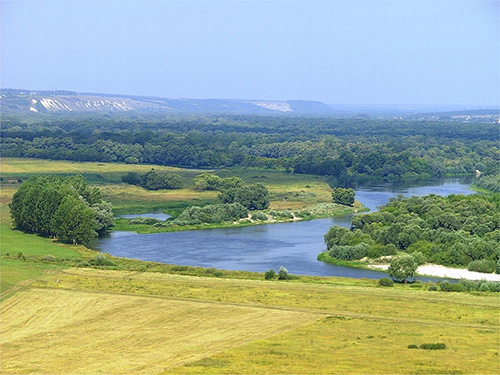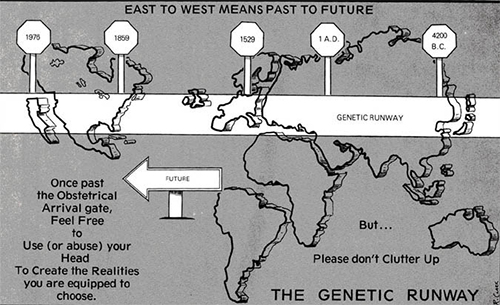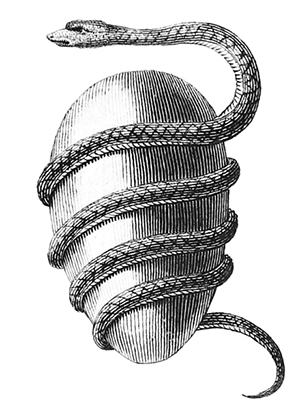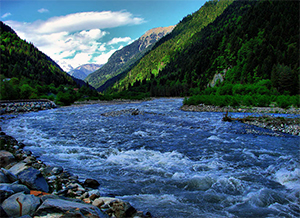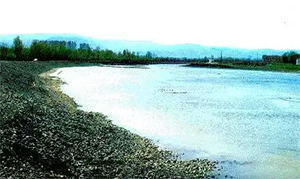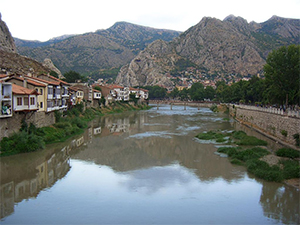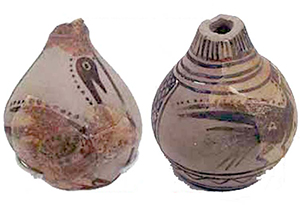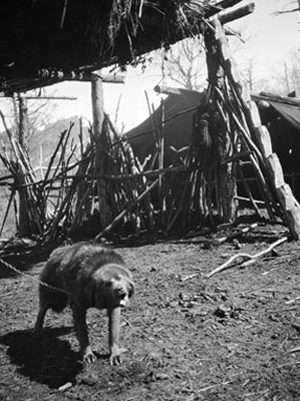Volume 3, p. 1-63
Of the Migration and Dispersion of Nations
[x]. Georgius Monachus, p. 66.
In the Mosaic history we have an account of the antediluvian world being destroyed by a deluge, the family of one man excepted, which was providentially preserved. The manner of their preservation I have described; and have shewn that the ark rested upon Mount Ararat, in a province of Armenia. This was the region in which mankind first began to multiply, and from whence they afterwards proceeded to their different places of allotment. It will therefore be necessary to give some account of this country; as from such an inquiry we shall find innumerable evidences still arise in confirmation of the primaeval history: and there will be also many proofs obtained in confirmation of my opinion, concerning the migration of mankind.
Armenia lay to the north of Aramea, or Mesopotamia: and one might be led to think, from the similarity of terms, that Armenia and Aramea were the same name. This, however, was not the case. Aramea was the land of Aram: but Armenia, which was separated from it by1 [Strabo. L. 11. p. 792. 798.] Mount Taurus, was denominated from Ar-Men, and Har-Men, the mountain where the ark rested. It was a branch of the abovementioned Taurus: and was distinguished by several appellations, each of which was significant, and afforded some evidence to the history of the deluge. It was called Ararat, Baris,2 [See Vol. II. of this work, p. 442.] Barit, Luban, which last signified Mons Lunaris, or the Mountain of Selene. It had also the name of Har-Min, and Har-Men, which was precisely of the same signification. The people who lived round it were called Minni and Minyae; and the region had the name of Armenia from the mountain, which was the great object of reverence in this country. The name is to be found in the prophet Jeremiah, where he is calling together various foreign powers to make an invasion upon Babylon.3 [Jeremiah, c. 51. v. 27. Sulcitate super eam gentes; annunciate adversus illam regibus Ararath Menni. Vulgate. [Google translate: Sing praises to her, O nations; declare against her to the kings of Ararat and Minni.]]
Set up a standard in the land; blow the trumpet among the nations; prepare the nations against her. Call together against her the kingdoms of Ararat Minni, and Ashchenaz.
By Ararat-Minni is signified the region about Mount Ararat, which was possessed by the Minyae. The passage is by the Chaldee Paraphrast very justly rendered [x], Armini, the same as Armenia. From hence the learned Bochart infers with good reason, that the name of Armenia was taken from this Ararat of the Minni, called Ar-Mini.4 [Geog. Sacra. L. i. c. 3. p. 20.] Videtur Armeniae vox conflata esse ex [Google translate: The voice of Armenia appears to be fused] [x], Har Mini, id est Mons Mini [Google translate: Har Mini, which is Mini Mountain], five Montana Miniadis. Something similar is to be found in Amos; where the same mountain is mentioned under the name of [x],5 [C. 4. v. 3.] Har-Munah, or mountain of the Moon.6 [ ] Jerome takes notice of this passage, and mentions how differently it has been rendered by expositors; a circumstance which must happen, when writers are of different countries and of different times.6 [ Hieron. et Theodoretus. See Bochart. Geog. Sacra. L. i. c. 3. p. 20.] Hieronymus et projiciemini inquit in locis Armeniae, quae vocantur Armona. Denique Symmachus ita interpretatus est, et projiciemini in Armenia: pro quibus LXX montem Remman, Aquila montem Armona, Theodotio montem Mona. [Google translate: Jerome says, "You will be cast in the places of Armenia they are called Armona. Finally Symmachus interpreted this and you will be cast into Armenia: for which 70 Mount Remman Aquila mount Armona, Theodotius mountain Mona.]7 [Bochart supra. p. 20. [x]. Ibid.] Bochart, who quotes this passage, at the close asks, What if Mini, Minyas, and Monah should after all prove to be the same name, only differently expressed? We may safely answer that they are; and that they relate to the same history. Even the Remman of the LXX is a transposition of the true name; and a mistake for8 [This is manifest from the Vulgate, in which it is rendered, Et projiciemini in Ar-mon.] Ar-Man, the same as Ar-Mini in the Chaldaic Paraphrase, as Ar-Mona of Aquila, Ar-Muna of Amos, and the Mountain Mona of Theodotion. They all signify Mons Lunus, and relate to the Arkite emblem Selene, of which I have before treated.
The most common name given to the mountain was Ararat; and by this it has been distinguished by Moses. This is a compound of Ar-Arat, and signifies the Mountain of Descent, and is equivalent to [x], of the Hebrews. That the name was a compound of Ar-Arat, is plain from Hatho the Armenian, who mentions it out of composition by the name of Arath:9 [Hatho Armenius. See Purchas. Vol. 3. p. 110.] In Armenia edt altior mons, quam fit in toto orbe terrarum, qui Arath vulgariter nuncupatur; et in cacumine illius mentis arca Noae post diluvium primo stetit. [Google translate: In Armenia the mountain is higher than it does in all over the world, which is commonly called Arath; and At the top of that mountain, the ark of Noah stood first after the flood.] Josephus tells us expressly, that it was called by the natives the Mountain of Descent, which he translates [x], on account of the Patriarch here first descending from the ark.10 [Josephus. Antiq. Lib. i. c. 3. p. 16.] [x]. The same is mentioned by11 [[x]. Eustathius Antiochenus. See Bochart above, p. 20.] Eustathius Antiochenus. By Jerome it is styled the place of exit.12 [Hieron. in Eusebianis.] Nunc locum Armenii exitum vel egressum vocant. [Google translate: Now place Armenians going call or exit.] The sacred writer seems to have industriously expressed the name of this mountain, as it was exhibited by the natives. He accordingly calls it in the provincial dialect13 [Pro [x] Mosis reperitur in Codice Samaritano [Google translate: For Moses is found in the Samaritan Code] [x], Hararat. Le Clerc. Vol. i. p. 72.] Ar-Arat; which would have been rendered Har-Irad by the Hebrews. By this is signified [x], or place of descent. The region round about was called Araratia, and also Minyas, where the Minyae resided, of whom I have taken notice before. This probably, after the general migration, was one of the oldest colonies in the world. Nay, it is not impossible, but that the region may have been originally occupied by a people styled Minyae, who out of a false zeal adhered to the spot, and would never depart from it. From the similitude which the natives of these parts bore to the Syrians and Arabians, in religion, customs, and language, it appears plainly that they were one of the14 [[x]. Strabo, L. i. p. 70. One of the principal cities in this part of Armenia was Cu-Coufus, which signifies the place of Chus. See Hierocles [x]. p. 703. [x].] Cuthite branches.
We may be assured, that the ark was providentially wafted into Armenia; as that region seems to have been particularly well calculated for the reception of the Patriarch's family, and for the repeopling of the world. The soil of the country was very fruitful, and especially of that part where the Patriarch first made his descent. Some have objected to the Mosaic account of the dove and olive, and will not allow that the ark could have rested in Armenia, because travellers of late have discovered no olives in that15 [Tournefort. Letter 7th.] country: they therefore infer that there never were any trees of this sort in that region. In like manner, there may be in these days no balsam at Jericho, nor date trees in Babylonia: but it does not follow that there were none of old. We must not therefore set aside ancient histories faithfully transmitted because the same occurrences do not happen at this day. But the inference is not only trifling, but false. Strabo was a native of Asia Minor; and he speaks of the fertility of Armenia, and especially of the region Gogarene, which he particularly mentions as productive of the olive.16 [L. 11. p. 800.] [x]. He had been speaking of various parts of Armenia, and then adds,
After these succeeds Gogarene. All this country abounds with fruits and trees for the use of man, and with those also which are evergreen. It likewise produces the OLIVE.
I have mentioned that Arene was one name of the ark; and many places were so denominated in memorial of it. It is to be observed that there is scarcely any eastern name which begins with a vowel or common aspirate, but is at times to be found expressed with a guttural. The city Ur was called Cur, Cour, and Chora: Aza was rendered Gaza: Ham, Cham; Hanes, Chanes: Hala, Habor, and Haran; Chala, Chabor, and Charan. So Arene, an ark or ship, was expressed17 [Many places are to be found in Media, Susiana, and Armenia, named Carene and Carina. See Cluver. Geog.] Carene: from whence came the Carina of the Romans. The term Go-Carene ([x]) signifies literally the place or region of the ark. I do not, however, imagine, that this was precisely the spot, where the18 [Gogarene was beyond the Cyrus, and a northern province. See Strabo, Stephanus, and others. It was at too great distance from Ararat, which was upon the river Araxes.] descent was first made, though the name was given in memorial of that event; a circumstance common to many other places. I make no doubt but that the region of the Minyae, at the foot of Mount Arad, or Ar-Arat, was the district where the Patriarch and his family first resided. It was upon the river19 [The Araxes is properly the river of Arach, or Aracha, which signifies the river of the ark.] Araxes, and one of the mediterranean provinces of Armenia. It was called20 [Isaiah. c. 37. v. 38. and 2 Kings, c. 19. v. 37. Ararat, regio Armeniae. Hieron. in Isaiam. Araratia, in medio regionum (Armeniae) loco. Moses Chorenensis. Geog. p. 361. [Google translate: Isaiah. c. v. and 2 Kings, c. v Ararat, the region of Armenia. Hieron In Isaiah Araratia, in the middle of the regions (Armenia) Moses of Chorenensis Geog. p. 361] Ararat and Araratia from the mountain; and seems to have been a fine21 [Habet Araratia montes camposque, atque omnem soecunditatem. Idem. p. 361. [Google translate: Ararat has mountains and plains, and all the land. The same thing p. 361.] country, productive of every thing necessary for life. The whole of Armenia appears to have been22 [Habet Armenia rerum ubertatem. Id. p. 358. Strabo says of Armenia, [x]. L. 11. p. 800.] fruitful; and we have the attestation of Strabo that it produced the olive. It seems, for the most part, to have been of a very high situation. One province was styled, on this account, Armenia Alta. It bordered upon Araratia westward; and the account given of it by Moses Chorenensis is remarkable.23 [Geog. p. 358.] Armenia Alta inter omnes regiones revera altissima est; quippe quae ad quatuor coeli partes fluvios emittit. Habet praeterea montes tres, feras plurimas, aves utiles, thermas, falinas, atque aliarum rerum ubertatem, et urbem Carinam [Google translate: Armenia Alta inter all the regions in fact are very high; for the four things it sends out rivers in different parts of the sky. It has three mountains plenty of wild beasts, useful birds, bathhouses, fawns, and other animals the richness of things and the city of Carina.].
Armenia Alta is one of the highest regions in the world; for it sends out rivers in contrary directions towards the four cardinal points in the heavens. It has three mountains, and abounds with wild animals, and species of fowl for food, also with hot baths, and mines of salt, and with other things of utility; and the chief city is called24 [Some of the principal cities in Armenia were Carina, Arca, Comana, Ararathia, Cucoufus. See Hierocles [x]. p. 703. These names are very remarkable.] Carina.
The region styled Araratia was also very high, though it had fine plains and valleys between the mountains. A country of this nature and situation must, after the flood, have been soonest dried, and consequently the soonest habitable. And it seems also, in an eminent degree, to have contained every requisite for habitation. The mountain still has the name of Ararat, which it has retained through all ages; and the province beneath is at this day peculiarly styled25 [Ermenia of D'Anville. See his curious map of Armenia, entitled, Carte generale de la Georgie et de l'Armenie, definee a Petersbourg, en 1738, d'apres les Cartes, Memoires, et Observations des Gens du Pays, &c. publiee en 1766. [Google translate: Ermenia of D'Anville. See his curious map of Armenia, entitled, Carte generale de la Georgie et de l'Armenie, definee a Petersbourg, en 1738, d'apres les Cartes, Memoires, and Observations des Gens du Pays, &c. public en 1766]] Ar-Meni. This name seems by the natives to have been originally limited to the 26[It was the same as Ararat, which was extended in the same manner. But Jerome says, Ararat non est tota Armenia. L. 11. in Esaiam. [Google translate: "Ararat is not all Armenia." L. 11. in Isaiah.]] region of the ark; but writers in after times have spoken of it with a greater latitude, and extended it to a large country. It was of great repute, and its chief city very ample, before it was ruined by the Tartars. The learned Roger Bacon mentions that it once had eighty churches:27 [Rogeri Baconi Pars major de Aquilonaribus Mundi partibus. See Purchas, Vol. 3. P. 55. [Google translate: Roger Bacon's Major Part of the Northern Parts of the World. See Purchas, Vol. 3. P. 55] Fuerunt in ea civitate octoginta ecclesiae Hermenorum [Google translate: They were in that city eighty to the church of the Hermenians.].
The mountain was also called28 [See Cartwright's Travels, p. 30. and William de Rubruquis. c. 48. [x]. Strabo. L. 11. p. 772.] Masis, and likewise Thamanim and Shamanim, the purport of which is remarkable. I have before taken notice of the sacred Ogdoas in Egypt, which was held in great veneration. It consisted of eight29 [See Vol. II. of this work, p. 234.] personages described in a boat, who were esteemed the most ancient gods of the country. This number was held sacred, and esteemed mysterious by other nations. It is observable that the Chinese have somewhat more than two hundred principal elementary characters; and out of these all other representations are formed by which in writing they express their ideas. By these combinations the characteristic is, in some degree, made a definition of the thing represented, and it has often a relation to the original history. Some of these have a reference to this mystical number eight, of which I shall give two instances of a very curious nature. They are taken from the letter of that learned Jesuit at30 [Lettre de Pekin fur le Genie de la Langue Chinoise, &c. A Bruxelles, 1773. p. 32.] Pekin, who wrote in answer to some queries sent by the Royal Society at London. Le caractere de barque, vaisseau, est compose de la figure de vaisseau, de celle de bouche, et du chissre huit: ce qui peut faire allusion au nombre des personnes, qui etoient dans l'arche. On trouve encore les deux caracteres huit, et bouche avec celui d'eau pour exprimer navigation heureuse. Si c'est un hazard, il s'accorde bien avec le fait. [Google translate: The boat character, ship, is composed of the figure of ship, of that of mouth, and number eight: which may allude to the number of the people who were in the ark. We find again the two characters eight, and mouth with that of water to express happy browsing. If it is a coincidence, it agrees well with the fact.] The same reference to the number eight is to be observed in the history of Mount Masis, or Ararat. It was called the Mountain Thamanim, or Tshamanim; and there was a town towards the foot of the mountain of the same name, which was supposed to have been built by Noah. Now Thaman is said in the ancient language of the country to have signified eight, and was analogous to the [x], Shaman, of the31 [See Bochart. Geog. Sacra. L. i. p. 18.] Hebrews, which denotes the same number. Ebn32 [Vol. i. p. 40. Vocatur autem hodie terra Thamenin. In another place he adds, Cumque egressi essent, urbem extruxerunt, quam Thamanin appellarunt, juxta numerum fuum, quasi dicas, Nos Octo sumus. p. 43. [Google translate: Vol. i. p. 40. And this day is called the land of Thamenis. In another place he adds, And when they were departing, they built a city, which they called Thamanin, near the number one, as if you were saying, We are eight. p. 43.]] Patricius mentions the Ark resting upon Ararat, and calls the district below the region of the Thamanin. He also mentions the city of the same name; and he says, that it was so called from the eight persons who came out of the Ark. Other writers express it Thamanim, which is a plural from Thaman. Terra Thamanim signifies the region of the eight persons; whose history needs no explanation. It is so rendered by Elmacini, who speaks of the town, and styles it,33 [L. i. c. i. p. 14. Thamininum vel Thsamininum pagum. [x]. Agathias, L. 4.] pagum, quem extruxit Noa, postquam ex Arca egressus est [Google translate: the village which Noa built after the Ark left]:
the place, which Noah built, after that he came out of the ark.
William de Rubruquis, who travelled into Tartary in the year 1253, and returned by Armenia, has a remarkable passage to this purpose.34 [See Purchas, Vol. 3. p. 50. but especially the original. Araxi et Naxuanae duos imminere montes Massis nomine; in quibus Arca resedit: et Cemainum oppidum ab octo illis ibi conditum, qui ab Arca exiverunt: idque patere ex ipso nomine, quo octo significatur. Rubriquis. The town of Naxuan is mentioned by Ptolemy, L. 5. c. 13, and placed upon the Araxes. In the map of D'Anville, it is expressed Nactshevan; and is situated upon the river, at a small distance from Mount Ararat.]
Near the city Naxuan, there are mountains called Masis, upon which they say that the Ark of Moses rested. There are two of these mountains, the one greater than the other, and the Araxes runneth at the foot of them. There is also a little town Cemainum, which is by interpretation eight; for they say it was so called from the eight persons who came out of the Ark, and built it. This is plain from the name; for Cemainum signifies eight. They call the mountain the mother of the world.
From hence we may perceive that what this writer renders Cemainum should rather have been expressed Shemainum, or Shemanum; for it is undoubtedly the same as the Themanim and Thamanim of Elmacini and others, and analogous to the [x], Shaman of the Hebrews. The town of the Thamanim, or Shamanim, was so called from those eight primaeval persons who were said to have founded it. There is reason to think that it was the same as Naxuan, a very ancient city, which is mentioned by Ptolemy, and placed upon the Araxes. The editor of Moses Chorenensis has some curious observations upon the history of this place.35 [L. i. c. 29. p. 71.]
This town, which seems to be the Naxuana of Ptolemy, is close upon the plain of Araratia; and held in great regard by the Armenians, who give out that it is the most ancient place in the world, and built immediately after the Deluge by Noah. Galanus, a Roman Presbyter, who wrote an account of the Armenian Church being reconciled to the Church of Rome, tells us that, according to the natives, the true name is Nachidshevan. By this, they say, is signified36 [I believe that the name related to the history of the Patriarch; but whether the etymology is precisely true, I question.] THE FIRST PLACE OF DESCENT. Hence there can be no doubt but this is that place in Armenia of which Josephus takes notice and says, that by the natives it was called [x], or the place of37 [Josephus. Ant. L. i. c. 3. p. 16.] descent.
In the map of D'Anville it is expressed38 [They have a tradition that Noah died here. See Tavernier. L. i. c. 4. p. 16.] Nactshevan, and placed at the distance of a few miles to the east of Mount Ararat, in the true region of Har-Men, or Armenia, which retains its name to this day.
I have mentioned that the same names have been given to different places, where the Arkite rites were instituted under the titles of Baris, Meen, and Selene. Hence the same event was supposed to have happened in different places, and the like history has been recorded.
It is difficult to imagine that two different dynasties could have identical or almost identical dynasty functions. The probability of such a coincidence is extremely small already for dynasties composed of 10 rulers. Nevertheless, the number of such coincidences, for even longer dynasties of 15 rulers, turns out to be unexpectedly large. N.A. Morozov, who noticed the coincidence between the ancient Rome and the ancient Jewish state, discovered the first examples of surprisingly identical pairs of dynasty graphs. A formal method to study such similarities was introduced by A.T. Fomenko (see the reference list in [2]).
There is another surprise, besides coincidence of the dynasty functions, the other numerical functions confirm with very high probability that these dynasties are indeed the same. It brings us to a suspicion that in fact we are dealing with repetitions in the conventional version of the history. Fomenko discovered dozens of strong coincidences, sometimes between three and more dynasties. But, there are no more such coincidences in the history of the better-documented epochs, for example starting from the 16th century....
These parallels suggest that the traditional history of ancient times consist of multiple recounts of the same events scattered in many locations at various times. The first scientist who realized it was N.A. Morozov (see [1]). Further progress was made by A.T. Fomenko who succeeded to decipher the principle structure of these duplicates in Roman and Biblical history.
-- Investigation of the Correctness of the Historical Dating, by Wieslaw Z. Krawcewicz, Gleb V. Nosovskij and Petr P. Zabreiko
Mount Taurus extended a great way eastward of Armenia: and one part of it, in the province of Adarbayn in Persia, is still called Al Baris, similar to the name by which Ararat was of old distinguished.39 [He calls the ridge of Taurus El Bors, p. 197. This is a variation of El Baris. Taurus is expressed by the natives Tabaris: from whence we may infer, that the former term is only a contraction of the latter; and that from Tabaris and Tavaris came the names of Tauris and Taurus, both the city and mountain. Har Ta-Baris is the mountain of the Ark.] Sir Thomas Herbert travelled this way in 1626; and he mentions one peak near the city Tauris remarkably high, which he with great reason imagines to have been one of those where stood the Iasonea mentioned by Strabo. This hill was called40 [P. 201.] Da Moan; and the town at the foot of it had the same name. By this, according to the natives, is signified [a second plantation. But Mon and Moan was the name of the Arkite type, as I have abundantly shewn: and "Da" was the ancient41 [See of this work Vol. II. p. 443.] Chaldaic particle analagous to "the" in our own language. Da Maon related to the Arkite Moon, and the history of the place still evidences the fact, for they have an ancient tradition that the Ark was driven to this mountain.42 [Herbert's Travels, p. 201. The mountain Da Moan signifies Mons Lunus, or Lunaris.]
They spare not to aver, says the author, from a tradition, that upon this mountain of Damoan the Ark rested.
Hard by is a village named Morante, where they suppose the wife of43 [Tavernier. L. i. c. 4. p. 20.] Noah to have died. I mention these accounts, however inaccurately transmitted, to shew how universal the history was of that great event, of which I have been treating. The scene of action was attributed to different places; but the real appulse [act of striking against something (such as a point)] of the ark was upon the mountain of Arat, called Ar-arat, in the province of Har-Men, upon the river Arach, or Araxes.
After the sacred writer has described the preservation of Noah and his family, and their descent from the Ark, he gives a short history of the Patriarch, and mentions his residence upon the spot, and his planting of the44 [Genesis. c. 9. v. 20, 21.] vine. He afterwards proceeds to shew how the reparation of mankind was effected in that family, and how they multiplied upon the earth. When they were greatly increased, he gives a list of their generations, and describes them with great accuracy upon their separating, according to their places of destination: and concludes with telling us, 45 [Genesis. c. 10. v. 5.]
By these were the isles of the Gentiles divided in their lands; every one after his tongue, after their families, in their nations.
And again,46 [Genesis. c. 10. v. 32.]
These are the families of the sons of Noah, after their generations, in their nations; and by these were the nations divided in the earth, after the flood.
I have spoken upon this subject in a former47 [Observations and Inquiries relating to various parts of Ancient History, p. 261.] treatise; and have shewn that this distribution was by the immediate appointment of God. We have full evidence of this in that sublime and pathetic hymn of Moses, where he addresses himself to the people whom he had so long conducted, and was now going to leave for ever.48 [Deuteron. c. 32. v. 7.]
Remember [says he] the days of old; consider the years of many generations. Ask thy father, and he will shew thee; thy elders, and they will tell thee. When the Most High divided to the nations their inheritance; when he separated the sons of Adam; he set the bounds of the people, according to the number of the children of Israel: for the Lord 's portion is his people; Jacob is the lot of his inheritance.
By this we may see, that the whole was by God's appointment; and that there was a reserve for a people who were to come after. St. Paul likewise speaks of it expressly as a divine ordinance.49 [Acts. c. 17. v. 26.].[x]
God made of one blood all nations of men for to dwell on all the face of the earth; and determined the times before appointed, and the bounds of their habitation.
This is taken notice of by many of the fathers. Eusebius in particular mentions50 [[x]. Euseb. Chron. p. 10.] the distribution of the earth: and adds,
that it happened in the two thousand six hundred and seventy-second year of the creation, and in the nine hundred and thirtieth year of the Patriarch's life. Then it was that Noah, by divine appointment, divided the world between his three sons.
The Masoretic Text of the Torah places the Great Deluge 1,656 years after Creation, or 1656 AM (Anno Mundi, "Year of the World"). Many attempts have been made to place this time-span at a specific date in history. At the turn of the 17th century CE, Joseph Scaliger placed Creation at 3950 BCE, Petavius calculated 3982 BCE, and according to James Ussher's chronology, Creation took place in 4004 BCE, dating the Great Deluge to 2348 BCE.
-- Genesis flood narrative, by Wikipedia
The like is to be found in51 [Syncellus. p. 89.] Syncellus,52 [Epiphanius. L. 2. t. 2. p. 703.] Epiphanius, and other writers. The Grecians had some traditions of this partition of the earth, which they supposed to have been by lot, and between Jupiter, Neptune, and Pluto.
53 [Callim. Hymn, in Jovem. v. 61.]
The sons of Cronus ascertain'd by lot
Their several realms on earth.
Homer introduces Neptune speaking to the same purpose,
54 [Iliad. O. v. 187.] [x].
We are from Cronus and from Rhea sprung,
Three brothers; who the world have parted out
Into three lots; and each enjoys his share.
The tradition probably came to Greece from Egypt; and we have it more fully related in Plato.55 [In Critia. Vol. 3. P. 109.] [x].
The gods of old obtained the dominion of the whole earth, according to their different allotments. This was effected without any contention; for they took possession of their several provinces in an amicable and fair way by lot.
It is said of Noah, from whom all the families upon earth were derived,56 [Genesis. c. 6. v. 9.] that he was a just man, and perfect in his generation: and that he walked with God. We may suppose that his sons shewed him always great reverence: and after they were separated, and when he was no more, that they still behaved in conformity to the rules which he established. But there was one family which seems to have acted a contrary part; and however they may have reverenced his memory, they paid little regard to his institutions. It is said, that57 [Genesis, c. 10. v. 8.]
Cush begat Nimrod. He began to be a mighty one in the earth. He was a mighty hunter before the Lord: wherefore it is said, Even as Nimrod, the mighty hunter before the Lord. And the beginning of his kingdom was Babel, and Erech, and Accad, and Calneb, in the land of Shinar. Out of that land went forth Ashur, and builded Nineve, and the city Rehoboth, and Calah, and Resen, between Nineve and Calah, the same is a great city.
We have, in this narration, an account of the first rebellion in the world; and the grounds of this apostasy seem to have been these. At the distribution of families, and the allotment of the different regions upon earth, the house of Shem stood first, and was particularly regarded. The children or Shem were Elam and Ashur, Arphaxad, Lud, and Aram. Their places of destination seem to have been not far removed from the region of descent, which was the place of separation. They in general had Asia to their lot, as Japhet had Europe, and Ham the large continent of Africa. And in Asia, the portion of Elam was to the east of the river Tigris, towards the mouth of it, which country, by the Gentile writers, was styled Elymais: and opposite to him, on the western side, was Amur. In like manner, above Ashur, upon the same river was Aram, who possessed the countries called Aram and Aramea: and opposite to him was Arphaxad, who in after times was called58 [Justin. L. i. c. 3. Ptolemy expresses the country Arrapachitis. L. 6. c. I. The chief city was Artaxata.] Arbaches and Arbaces, and his country Arphacitis. Lud probably retired to Lydia, and bordered upon the sons of Japhet, who were possessed of some regions in Asia Minor. This was the original disposition of these families; but the sons of Chus would not submit to the divine dispensation; and59 [[x]. Chron. Paschale. p. 28. Nimrod was styled Orion, and Alorus by the Gentile writers; and is acknowledged to have been the first king upon earth, and to have reigned at Babylon. [x]. Euseb. Chron. p. 5. Syncellus says the same, p. 37. 79. We meet with the same history in another place of the Chron. Paschale. p. 36. also Johan. Antiochen. L. 2. p. 18.] Nimrod, who first took upon himself regal state, drove Ashur from his demesnes, and forced him to take shelter in the higher parts of Mesopotamia. This was part of the country called Aram, and was probably ceded to him by his brother. Here the Ashurites built for their defence a chain of cities equal in strength and renown to those which had been founded by Nimrod. We have, in this detail, an account of the first monarchy upon earth, and of the tyranny and usurpations which in consequence of it ensued.
The sacred historian after this mentions another act of a rebellious purpose, which consisted in building a lofty tower with a very evil intent. Most writers have described this and the former event, as antecedent [before] to the migration of mankind, which they suppose to have been from the plains of Shinar: but it will be my endeavour to shew that the general migration was not only prior, but from another part of the world. The words of the historian are these:60 [Genesis.. c. 11. v. 1.]
And the whole earth was of one language, and of one speech. And it came to pass, as they journeyed from the east, that they found a plain in the land of Shinar; and they dwelt there. And they said one to another, Go to, let us make brick, and burn them thoroughly. And they had brick for stone, and slime had they for mortar. And they said, Go to, let us build us a city, and a tower whose top may reach unto heaven; and let us make us a name, lest we be scattered abroad upon the face of the whole earth. And the Lord came down to see the city and the tower, which the children of men builded. And the Lord said, Behold, the people is one; and they have all one language; and this they begin to do; and now nothing will be restrained from them which they have imagined to do. Go to, let us go down, and there confound their language, that they may not understand each other's speech. So the Lord scattered them abroad from thence upon the face of all the earth; and they left off to build the city: therefore is the name of it called Babel; because the Lord did there confound the language of all the earth; and from thence did the Lord scatter them abroad upon the face of all the earth.
It had been in the preceding chapter mentioned, where the family of Shem was enumerated, that
unto61 [Genesis. c. 10. v. 25. Peleg signified division.] Heber were born two sons; the name of one was Peleg; for in his days was the earth divided.
I think, that we may, from the preceding portions of Scripture, observe two different occurrences, which are generally blended together. First, that there was a formal migration of families to the several regions appointed for them, according to the determination of the Almighty: Secondly, that there was a dissipation of others, who stood their ground, and would not acquiesce in the divine dispensation. These seem to have been two distinct events, and to have happened in different places, as well as at different times. In the beginning of the latter history, mention is made of people's journeying, and proceeding towards a place of settlement. It is generally thought, that the whole of mankind is included in this description; and it is inferred from the words of Moses.
And the whole earth was of one language, and of one speech. And it came to pass, as they journeyed from the east, that they found a plain in the land of Shinar; and they dwelt there.
But I am not certain that these words afford any proof to this opinion: for, in respect to what is here said, I do not see but that a migration of families might have happened antecedently to this journeying from the east. The passage, when truly translated, does not by any means refer to the whole of mankind. According to the original, it is said indeterminately,
that in the journeying of people from the east, they found a plain in the land of Shinar.
The purport, therefore, of the whole passage amounts only to this, that before there was any alteration in the language of mankind, a body of people came from the east to the place above specified. This is all that is said: so that I am far from being satisfied that the whole of mankind was engaged in this expedition from the east. The Scripture does not seem to say so: nor can there be any reason assigned, why they should travel so far merely to be dissipated afterwards. We have reason to think, that soon after the descent from the Ark, the Patriarch found himself in a fine and fruitful country; for so it is described by62 [L. 11. p. 800. Ararat, regio in Armenia campestris est; per quam Araxes sluit; incredibilis ubertatis. Hieron. in Esaiam. c. 37. [Google translate: Ararat, a country in Armenia, is a plain; by whom Araxes slit incredible plenty. Hieron In Isaiah. c. 37] See Tavernier's Travels, p. 14, 15. and Tournefort. Letter 7th.] Strabo and others; and there is nothing that we can suppose to have been done at Shinar, but might have been effected in the spot where he first resided; I mean in respect to migration. The region about Ararat may be esteemed as nearly a central part of the earth; and it is certainly as well calculated as any other for the removal of colonies upon the increase of mankind. The Ethnic writers, in their accounts of the wanderings of Isis and Jonah, seem to allude to the journeying of mankind; and they speak of the country about Caucasus as the place from whence those travels began. The same is to be observed in the original history of the Minyae, which is called the retreat of the Argonautae: for they retire from the region about Caucasus to the remotest parts of the earth: and it is well known that Ararat in Armenia is a part of that vast chain of mountains called Caucasus and Taurus. Upon these mountains, and in the adjacent country, were preserved more authentic accounts of the Ark than almost in any other part of the world. Moses Chorenensis takes notice of the many memorials relating to ancient times which were preserved by the people of Armenia. They were commemorated in their poems, songs, and sacred hymns.63 [L. i. c. 5. p. 19.] Caeterum veteres Armenii in carminibus fuis, cantilenis ad cymbala, ac tripudiis, longe copiosiorem de his rebus mentionem agitant.
"The ancient Armenians in their poems and hymns, which are accompanied with cymbals and dances, afford a far more copious account of these events than any other nation.
The place where mankind first resided, was undoubtedly the region of the Minyae, at the bottom of Mount Baris, or Luban, which was the Ararat of Moses. Here I imagine, that the Patriarch resided; and64 [Apud Euseb. Chron. p. 8.] Berosus mentions that in this place he gave instructions to his children, and vanished from the sight of men. But the sacred writings are upon this head silent: they only mention his planting the vine, and seemingly taking up his abode for a long time upon the spot. Indeed, they do not afford us any reason to infer that he ever departed from it. The very plantation of the vine seems to imply a purpose of residence. Not a word is said of the Patriarch's ever quitting the place; nor of any of his sons departing from it, till the general migration. Many of the fathers were of opinion that they did not for some ages quit this region. According to Epiphanius, they remained in the vicinity of Ararat for five generations, during the space of six hundred and fifty-nine years.65 [Haeref. L. i. p. 5.] [x]
After the Ark upon the decrease of the waters had rested upon the mountains of Ararat, upon that particular eminence called Lubar, which bounds the countries of the Armenians and the Cardueans, the region where it settled became the first place occupied by mankind. Here the Patriarch Noah took up his residence, and planted the vine. In this place he saw a large progeny descend from him, children after children -- to the66 [The same is mentioned by this writer in another place. [x]. L. 1. p. 6.] fifth generation, for the space of six hundred and fifty-nine years.
During the residence of mankind in these parts, we may imagine that there was a season of great happiness. They for a long time lived under the mild rule of the great Patriarch, before laws were enacted or penalties known. When they multiplied, and were become very numerous, it pleased God to allot to the various families different regions, to which they were to retire: and they accordingly, in the days of Peleg, did remove, and betake themselves to their different departments. But the sons of Chus would not obey. They went off under the conduct of the archrebel Nimrod; and seem to have been for a long time in a roving state; but at last they arrived at the plains of Shinar. These they found occupied by Assur and his sons, for he had been placed there by divine appointment. But they ejected him, and seized upon his dominions, which they immediately fortified with cities, and laid the foundation of a great monarchy. Their leader is often mentioned by the Gentile writers who call him Belus. He was a person of great impiety; who, finding that the earth had been divided among the sons of men by a divine decree, thought proper to counteract the ordinance of God, and to make a different distribution. This is often alluded to in the Ethnic writings; and Abydenus particularly mentions, that67 [[x]. Euseb. Praep. Evang. L. 9. p. 457.] Belus appointed to the people their place of habitation. Dionysius refers to this Belus and his associates, when he is speaking of the deities, who were the ancestors of the Indo-Cuthites.
68 [V. 1173.]
They first allotted to each roving tribe
Their share of sea, and land.
This is the beginning of that period which, upon account of the rebellion then first known, was by the Greek writers alluded to under the title of [x], Scuthismus. This ejectment of Assur seems to shew, that these transactions were after the general migration; for he was in possession of the province allotted to him till he was ejected by this lawless people.
In the beginning of this history it is said that they journeyed from the east when they came to the land of Shinar. This was the latter part of their rout: and the reason of their coming in this direction may, I think, be plainly shewn. The Ark, according to the best accounts, both sacred and profane, rested upon a mountain of Armenia called Minyas, Baris, Lubar, and Ararat. Many families of the emigrants went probably directly east or west, in consequence of the situation to which they were appointed. But those who were destined to the southern parts of the great continents which they were to inhabit, could not so easily and uniformly proceed; there being but few outlets to their place of destination. For the high Tauric ridge and the69 [Strabo, L. 11. p. 798.] Gordyean mountains came between, and intercepted their due course. How difficult these mountains were, even in later times, to be passed may be known from the retreat of the ten thousand Greeks who had served under Cyrus the younger. They came from these very plains of Shinar; and passing to the east of the Tigris they arrived at these mountains, which with great peril they got over. But in the times of which we are treating they must have been still more difficult to be70 [In later times there were only two passages southward. Armenia orientales Ciliciae sines attingit, atque ad Taurum montem patet -- atque ex ea duo aditus in Syriam patent. [Google translate: Eastern Armenia It touches a dam in Cilicia, and extends to Mount Taurus - and from it there are two entrances to it Syria is open.] Moses Chorenens. Geog. p. 354.] surmounted: for after the deluge, the hollows and valleys between these hills, and all other mountainous places, must have been full of slime and mud; and for a great while have abounded with stagnant waters. We know from ancient history that it was a long time before passages were opened and roads made through places of this nature. I should therefore think that mankind must necessarily for some ages have remained near the place of descent from which they did not depart till the time of the general migration. Armenia is in great measure bounded either by the Pontic sea, or by mountains' and it seems to have been the purpose of Providence to confine the sons of men to this particular region, to prevent their roving too soon. Otherwise, they might have gone off in small parties before the great families were constituted, among whom the world was to be divided. The economy and distribution assigned by Providence would by these means have been defeated. It was upon this account that at the migration, many families were obliged to travel more or less eastward who wanted to come down to the remoter parts of Asia. And in respect to the Cuthites, who seem to have been a good while in a roving state, they might possibly travel to the Pylae Caspia, before they found an outlet to descend to the country specified. In consequence of this, the latter part of their rout must have been in the direction mentioned in the Scriptures, which is very properly styled a journeying from the east. I was surprised, after I had formed this opinion from the natural history of the country, to find it verified by that ancient historian Berosus. He mentions the rout of his countrymen from Ararat after the deluge; and says that it was not in a strait line, but people had been instructed 71 [Euseb. Chron. p. 8. [x]. Hesych.] [x],
to take a circuit, and so to descend to the regions of Babylonia.
In this manner, the sons of Chus came to the plains of Shinar, of which Babylonia was a part; and from hence they ejected Assur, and afterwards trespassed upon Elam in the region beyond the Tigris.
It may still be urged that all mankind must certainly have been at Babel:
for the whole earth
and its language are mentioned72 [C. 11. v. i.]; and it is said, that God confounded there the language of all the earth. But this, I think, can never be the meaning of the sacred writer: and it may be proved from the premises upon which those in opposition proceed. The confusion of speech is by all uniformly limited to the region about Babel. If we were to allow that all mankind were included in this spot, how can we imagine that the sacred historian would call this the whole earth? If mankind were in possession of the greater part of the globe this figurative way of speaking would be natural and allowable. But if they are supposed to be confined to one narrow interamnian district, it is surely premature, for we cannot suppose that the language of the whole earth would be mentioned before the earth was in great measure occupied, which they do not allow. And if what I assert be granted, that the earth was in some degree peopled, yet the confusion is limited to Babel; so that what is mentioned in the above passage can never relate to the whole earth.

